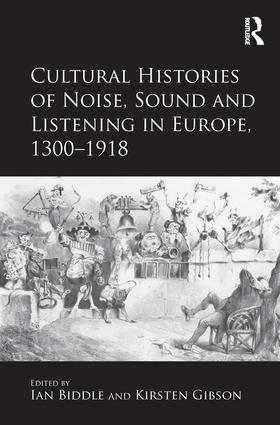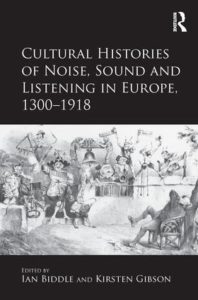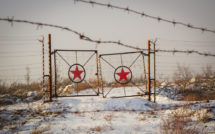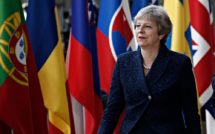
Cultural Histories of Noise, Sound and Listening in Europe, 1300–1918 by Ian Biddle Kirsten Gibson

This is a book emphatically conceived and structured to wrestle with multitudes. Its historical purview is vast, with each of its twelve chapters slicing its own share of the six centuries framed by the title, and each mapping its own relation to the idea of Europe. This vastness is not merely the by-product of the fact that Cultural Histories of Noise, Sound and Listening in Europe, 1300–1918 is an edited volume, in which some of the articles offer close readings of single primary sources and others condense whole research projects into a dozen pages. The editors, both musicologists by training with strong affinities for cultural history, emphasize that the history of sound is by definition “radically dispersed” (1)—across sources, among individuals, through spaces and materials, and via the mechanisms of political ideologies. This is an epistemic claim about sound and studying sound that they demonstrate with the richness of the volume at hand.
First and foremost, the concept of aurality challenges the coherence and autonomy of the modern subject. This collection complements Ana María Ochoa Gautier’s theorization of it in the context of nineteenth-century Columbia as “a force and formation that seeps” through modernity’s ideas, texts, and spaces, shaping listening practices and listeners themselves (Ochoa Gautier 2014, 5). The concatenation in Biddle and Gibson’s title (noise—sound—listening) likewise shapes a general trajectory from sound object through audible vibration to the knowledges—vernacular and otherwise—required to attend to and make meaning of sound. The many case studies and contexts that make up the volume—more about which below—together stake an empirical claim about the variegated terrain that is the history of listening. For Biddle and Gibson, the history of sound is also a crucial component of the formation of Europe as, following Frantz Fanon, an “affectively charged category” (4). By attending to patterns of European sociability and the shifts in these articulations of power and space over time, the editors underscore aurality’s inextricability from European hegemonies. Through historical confirmation of Europe, certain ontologies of music and sound became recognized to the erasure or misrecognition of others. (The contribution by Jim Sykes most directly takes on the mantle of this critique.)
Second, the primacy of expanse for this collection is a commentary on methodology and disciplinarity. The anthology insists upon the interdisciplinarity of sound studies, by now a prominent discourse across the academy, even celebrating the range of methodologies it demands of scholars—and teams of scholars—as “its greatest strength” (2). In doing so, the editors echo Jonathan Sterne’s emphasis on the interplay between transdisciplinary effort and disciplinary expertise in sound studies scholarship (Sterne 2012). However, Biddle and Gibson’s volume does not merely join in the sound studies chorus: it is a concerted effort to show the specific value of historical methodologies for the interdiscipline. The editors correctly observe that many of the recent anthologies that institutionalize sound studies have their focus on the present or, especially with the centripetal force of science and technology studies, the long century since the invention of the phonograph. With the noticeable exception of a duo of formative collected volumes (Smith 2004, Erlmann 2004), much of the pre-1800 sensory history with an emphasis on sound has been been published in monographs. A tremendous contribution of this book is to make clear that, contrary to many casual claims of archival silence, there are plentiful and fascinating historical sources. A skilled cast of scholars from art history, urban studies, literary studies, religious history, music philosophy, and music history are engaged in asking questions from sound studies of these materials; by bringing them together under one roof, the dialogic richness and theoretical potential of this work becomes apparent. I read this bounty as an invitation for further collaborative work and conversation, one that certainly would benefit from explicitly postcolonial and transnational approaches that are not as present in this collection as other cultural studies influences.
Biddle and Gibson group the chapters into three sections, each with their own brief synthesizing introduction. The organizing strategy usefully provides reading routes through the book. It keeps both chronology and geography in kaleidoscopic movement so as to foreground diversity. “Historicizing Aurality” draws out the recurring work of sound to mediate questions of perception, meaning, and the individual subject. The four authors (Lisa Colton, Veit Erlmann, Emily Laurance, and Alexander Bonus) zoom in on formative moments in sensory history through close reading. The radically divergent historical moments under examination—from the influence of experimental psychology on the development of the metronome to the importance of sound for Medieval mystics as they formulated written responses to the corporeal experience of faith—suggest that tensions between aesthetics, theology, and scientific inquiry have frequently splintered intellectuals’ understanding of affect as slippery and/or measurable.
The second section, “Sound Politics,” marks the book’s opening toward the public sphere as a space that coheres and challenges sonic epistemes. Each of the contributions (by Hedy Law, Jim Sykes, and Risto Pekka Pennanen) reveals the pernicious effect of legal regulations of sound while underscoring the social tensions among communities as they respond to imposed ideologies of listening. The chapters urgently recognize that sound as itself has been a historical agent, begetting events and cultural practices precisely because it was ontologically fixed by imperial and colonial contexts. The articles in the final section, “Urban Soundscapes of Europe,” most clearly share an intellectual project across the disciplines of architecture, literary, and music studies. These concise pieces (by Helen Coffey, Danielle V. Filippi, Adam Hansen, Olivier Balaÿ, and João Silva) focus on reconstructing historical sonic imaginations for particular European cities, building on empirical evidence of sounding events from amateur musical performances to the acoustic intensity of side streets flanked by echoic structures. Together, they raise questions about the acoustic profile of European modernity to reveal that noise—that “unwanted” category of sound—has always been in the mix. It cannot be written off (or avoided) as a contaminant of the industrial revolution.
If the whole volume is a constructive effort to open up sound studies to European cultural history, this final section is a directed response to the primacy of the rural in R. Murray Schafer’s influential theorization of the soundscape (Schafer 1994). Biddle and Gibson suggest as much in the introduction (9). The methodological routes into and out of cities are indeed promising sites for the reckoning with studies of sound and empire across the volume: I kept Sykes’s study of British Ceylon and Pennanen’s focus on Sarajevo from the previous section in mind as I dove into this last quintet of essays. One can easily imagine “Urban Soundscapes” sprawling into a more extended and collaborative project of cultural geography and urban studies that could and would benefit from moving beyond the European context. The conflicting auditory environments are ideologically loaded: they are, in the best sense, messy generators and sloppy hosts of the “feedback loop of materiality and metaphor” in which sound resides—to borrow the useful crucible offered by David Novak and Matt Sakakeeny in their own interdisciplinary take on sound studies (1). None of the scholars in Biddle and Gibson’s collection contends they have reconstructed a high-fidelity soundscape—or immersed themselves in the past. Instead, they read a range of documents—prospective (municipal planning), aesthetic (literary and musical projects), descriptive (travel and other forms of non-fiction writing), material (organological and architectural)—to imagine a range of everyday urban acoustics, never stable, but often intimate.
I came away from the experience of this book with a sense of momentum, even if the volume does suffer from some of the inconsistencies (in article length, in theoretical coherence, in intellectual scope) that plague edited collections. The act of anthologizing these differences sets the reader up to read and hear new connections. Erlmann’s article allows his monumental Resonance to converge with other reads on French musical theater and affect (Laurance and Law; Erlmann 2010). Theological ambivalence and certainty about sound strings along the contributions by Coffey, Colton, Filippi, Pennanen, and Sykes, raising questions about sound and secularization under European auspices. I might posit further routes through Biddle and Gibson’s collection along dyads that emerged: “cries”/noise, musical skills/hearing disabilities, and witnessing/perception, for example. But any reader will bring their own interests from cultural history, cultural studies, and sound studies to this collection. The editors enable generous and individualized tours through the volume, mapping an open blueprint for sound studies and cultural history in the process.
Reviewed by Andrea F. Bohlman, University of North Carolina at Chapel Hill
Cultural Histories of Noise, Sound and Listening in Europe, 1300–1918
By Ian Biddle and Kirsten Gibson
Publisher: Routledge
Hardcover / 279 pages / 2016
ISBN: 9781409444398
Bibliography
Erlmann, Veit. Hearing Cultures: Essays on Sound, Listening and Modernity. New York: Berg, 2004.
———. Reason and Resonance: A History of Modern Aurality. Cambridge, MA: Zone Books, 2010.
Novak, David, and Matt Sakakeeny. “Introduction.” In Keywords In Sound, edited by David Novak and Matt Sakakeeny. 1–11. Durham, NC: Duke University Press, 2015.
Ochoa Gautier, Ana María. Aurality: Listening and Knowledge in Nineteenth-Century Colombia. Durham, NC: Duke University Press, 2014.
Schafer, R. Murray. The Soundscape: Our Sonic Environment and the Tuning of the World. Rochester, VT: Destiny Books, 1994.
Smith, Mark M. Hearing History: A Reader. Athens: University of Georgia Press, 2004.
Sterne, Jonathan. “Sonic Imaginations.” In The Sound Studies Reader, edited by Jonathan Sterne. 1–17. New York: Routledge, 2012.
Published on August 6, 2018.




